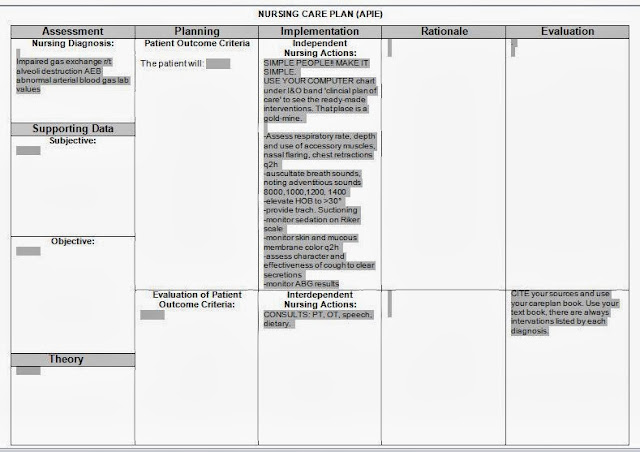Clinical
Here's An Example Of A Patho That Passed
copyright Janice Silbermann :)
Diabetes
Mellitus
Disease
of deficiency or resistance to the effects of insulin. Cells use insulin for
energy needs. Insulin also promotes fatty acid storage in the adipose tissues.
Type 1 diabetes is an absolute deficiency in insulin and type 2, which has a
later onset and is related to diet and life-style choices, is insulin resistance.
Diabetes
has a hereditary component in both types and along with obesity is a risk
factor. High cholesterol, triglycerides and high BP also constitute risk
factors
Diabetes
puts a patient at risk of multisystem complications including peripheral
vascular disease, heart disease and renal disease
Hyperglycemic
symptoms include polyuria, polydipsia, weight loss, fatigue, weakness and
frequent skin complications such as infections
Tests
include fasting plasma glucose levels. A reading of > 126 mg/dL is
considered high. Random blood glucose testing may reveal a level of >200
mg/dl. Oral dextrose (75g) is given in the third test and a BG level is
obtained 2 hours later. A reading of >200mg/dL is indicative of DM.
Treatment
includes changes in diet and exercise. Type 1 requires insulin replacement as
the body is not manufacturing insulin. Type 2 may be treated with oral
anti-diabetic drugs which will stimulate the body to produce insulin or increase
sensitivity at the cellular level. Injected insulin may also be used in Type 2.
Dietary measures include a consistent carbohydrate diet, which is calorie controlled
to maintain optimal weight. The diet is carefully calculated to keep BG levels
in optimal range.
Insulin
can be characterized by its rate of onset, peak and duration. Rapid (lispro),
for example has an onset of fewer than 15 minutes, while Lente has an onset of
1-3 hours, but lasts 18-24 hours in contrast with Lispo’s 3-4 hours duration.
LeMone, P., K.
Burke, and G. Bauldoff. Medical-surgical
nursing: Critical thinking in patient care. Fifth. Upper Saddle River, NJ:
Pearson Education,Inc., 2011. Print.
Here's An Example Of A Physical Assessment That Passed
Neurological: Not oriented to person, place and
time. Unresponsive to verbal commands. Withdraws from stimuli. Pupils equal,
round, reactive to light. Sluggish pupil response, 6cm bilaterally,
accommodation present. Unable to assess hand grips. Bilateral ankle
dorsificaton and plantar flexion, equal, weak.
Pulmonary: Trach present. control assist
ventilator, Vent Settings: Mode: assist
control FiO2:40% Rate:14
TV:420mL Vmax:50L/min Respiratory rate between 17-26 during 8 hour
shift. Tachypnea. Breathing labored and shallow, bilateral, equal use of
accessory muscles, no retractions. Chest rise equal bilaterally. Rhonchi
present upper left, upper right, lower left and lower right lobes. No cough.
Moderate
secretions, thick, blood-tinged.
Cardiac: Apical pulse 0800 -108bpm,
1000-119bpm, 1200-107bpm,1400-96, strong, regular. S1 and S2 present. No
murmurs heard. Sinus tachycardia. HR between 97-140 during 8 hour shift.
BP:
0800-141/74 1000-134/61 1200-101/42 1400-11/48-automatic cuff, left arm, taken
supine.
Radial
pulses, equal 3+ bilaterally. Doralis pedis pulses equal, 3+ bilaterally, tibial
pulses equal 3+ bilaterally. Cap refill right hand <3sec, left hand <3
sec, right foot <3 sec, left foot < 3sec.
Pitting edema
4+- bilateral hands, feet, thighs, ankles. Pitting edema 1+ above knee. Pitting
edema 1+ above elbow. Facial edema present.
No JVD
present.
GI/GU: Abdomen soft, round. Bowel sounds
heard immediately in all four quadrants. No rebound tenderness or masses. Bowel
movement 0930 1-28-13, soft, formed, brown, no foul odor. zero residual in
g-tube. Auscultation shows correct placement.
Urine clear,
dark yellow. Foley catheter. Tube feeding with Nova Source Renal 30 mL/hour.
NPO.
Musculoskeletal: Passive ROM in all extremities, unable
to move spontaneously. Unable to assess neck range of motion due to edema and
presence of trach collar. Gait and posture unable to assessed-non-ambulatory.
Integumentary: skin color normal for ethnicity. Skin warm and clammy on palpation. MM moist, pink. Not
tenting in upper extremities. Lower extremities edematous, skin tight and
shiny. Nail color pink. No clubbing observed. PICC line present right
antecubital. Dressing dry and intact, no drainage, no bleeding.
Large area of
reddened, denuded, sloughing skin both buttocks, both things, sacral area,
moist.











No comments:
Post a Comment